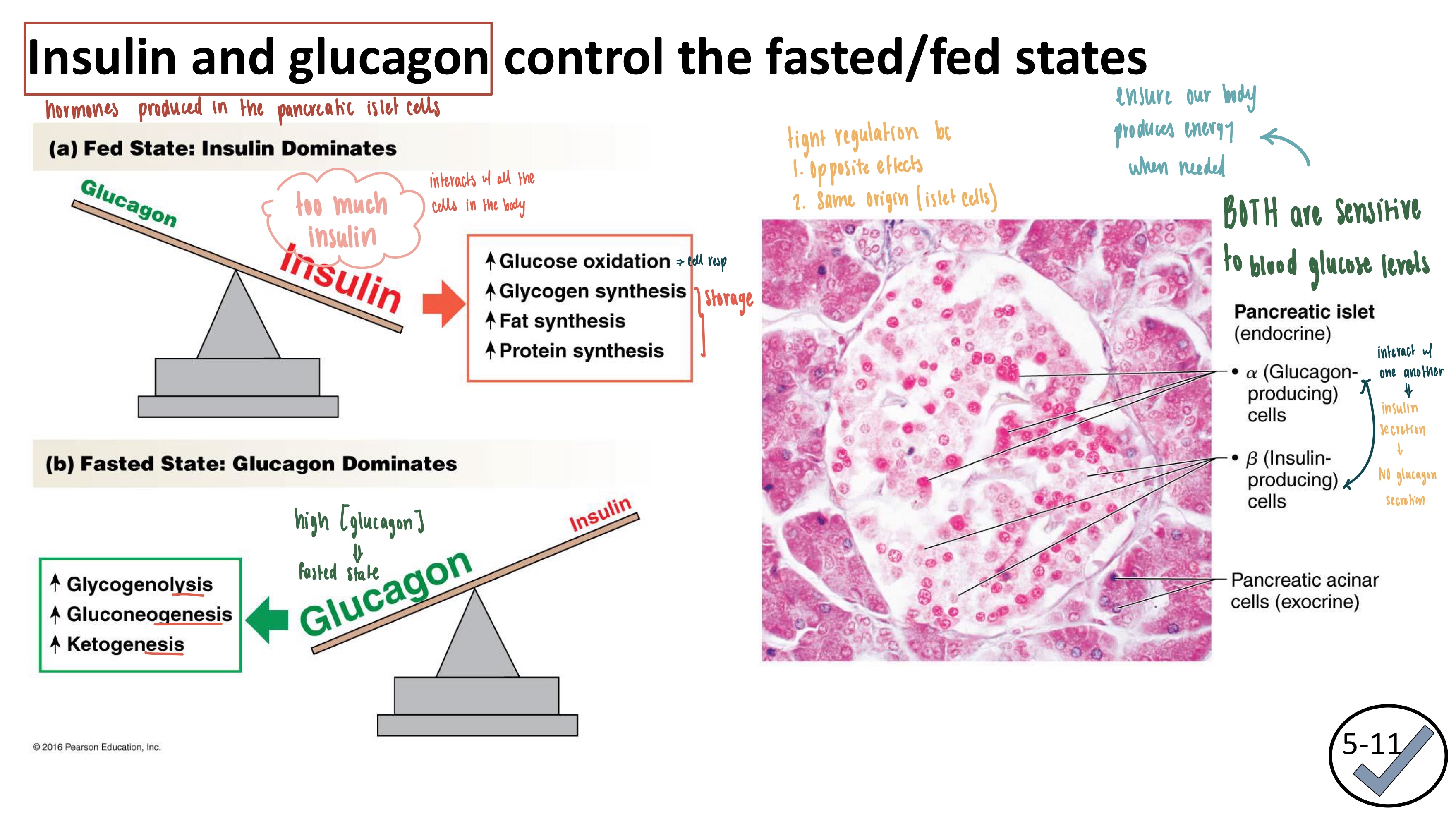BIO-249 Lecture Exam 5: Energy & Oxidative Metabolism
1/32
There's no tags or description
Looks like no tags are added yet.
Name | Mastery | Learn | Test | Matching | Spaced |
|---|
No study sessions yet.
33 Terms
In a sentence or two, describe metabolism.
What is anabolism and catabolism?
When energy is created or released, what unit of measurement is used to measure that energy within the body and within a cell?
Metabolism: Balance of energy storage and usage
the totality of all chemical reactions in the body
Catabolism: energy RELEASING (decomposition reactions)
big molecule → smaller molecules
Anabolism: energy consuming (synthesis reactions)
CREATING bonds to make BIGGER molecules
Energy unit: ATP or calories
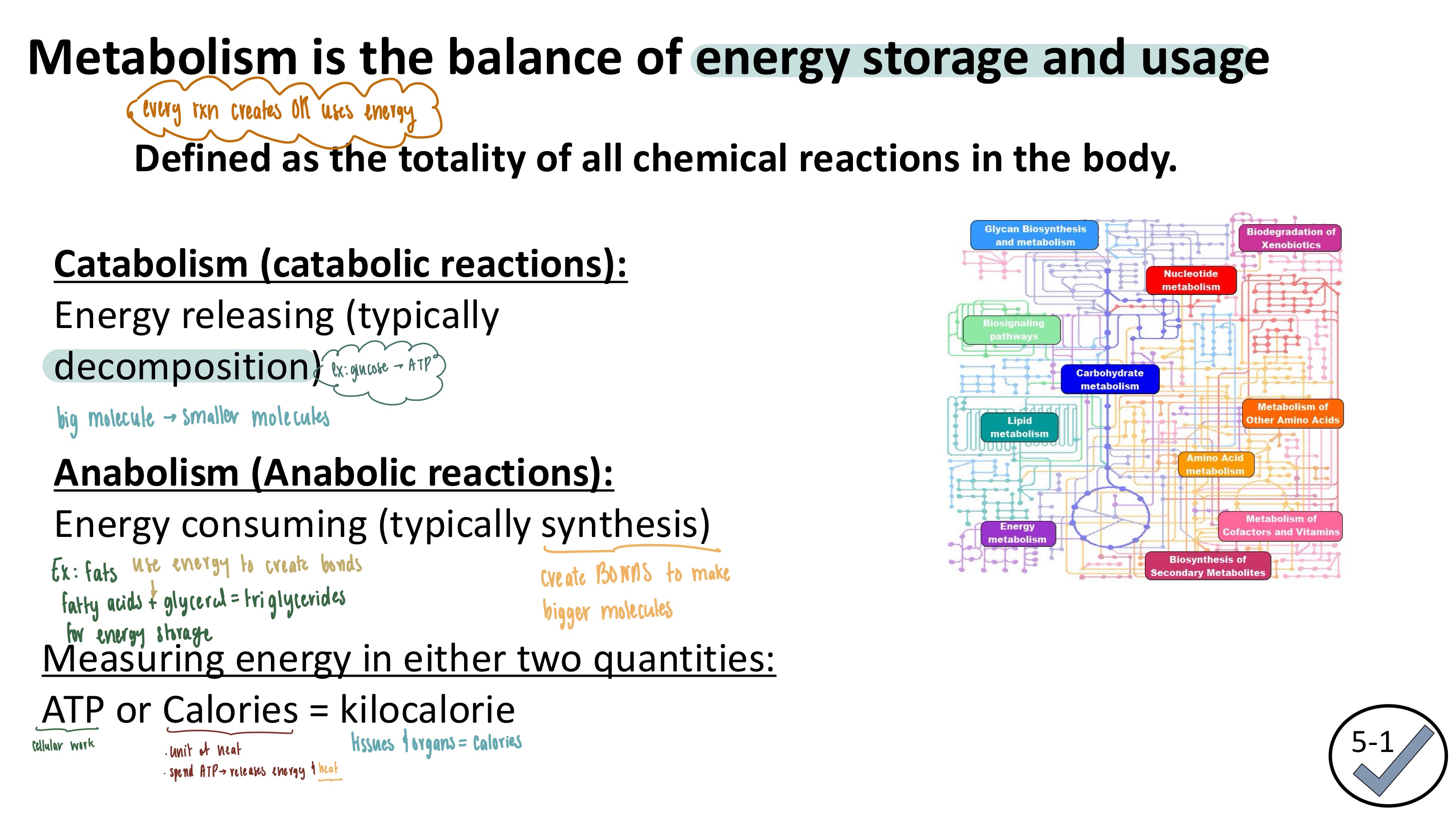
What are the reactants and products of cellular respiration?
Reactants
Glucose
O2
ADP
Products
H2O
CO2
ATP (cellular energy)

In a sentence or two, describe the basic chemical process (very abstract) of ATP synthesis.
What is phosphorylation?
In 2-4 sentences, describe the differences between substrate-level phosphorylation and oxidative phosphorylation
ATP Synthesis
Energy ise produced at the chemical level
2 ways of making ATP (substrate-level phosphorylation and oxidative phoshorylation)
Phosphorlyation: adding a phosphate group to a molecule
Substrate-level Phosphorylation
Using an enzyme to add a phosphate group to ADP
Occurs in the cystol & mitochondrial matrix
Very little ATP produced
Oxidative Phosphorylation
Uses the Electron Transport System (proteins that “pump” protons)
Uses the H+ gradient and ATP Synthase to create ATP
ONLY in the mitochondrial matrix
LOTS of ATP
Requires O2
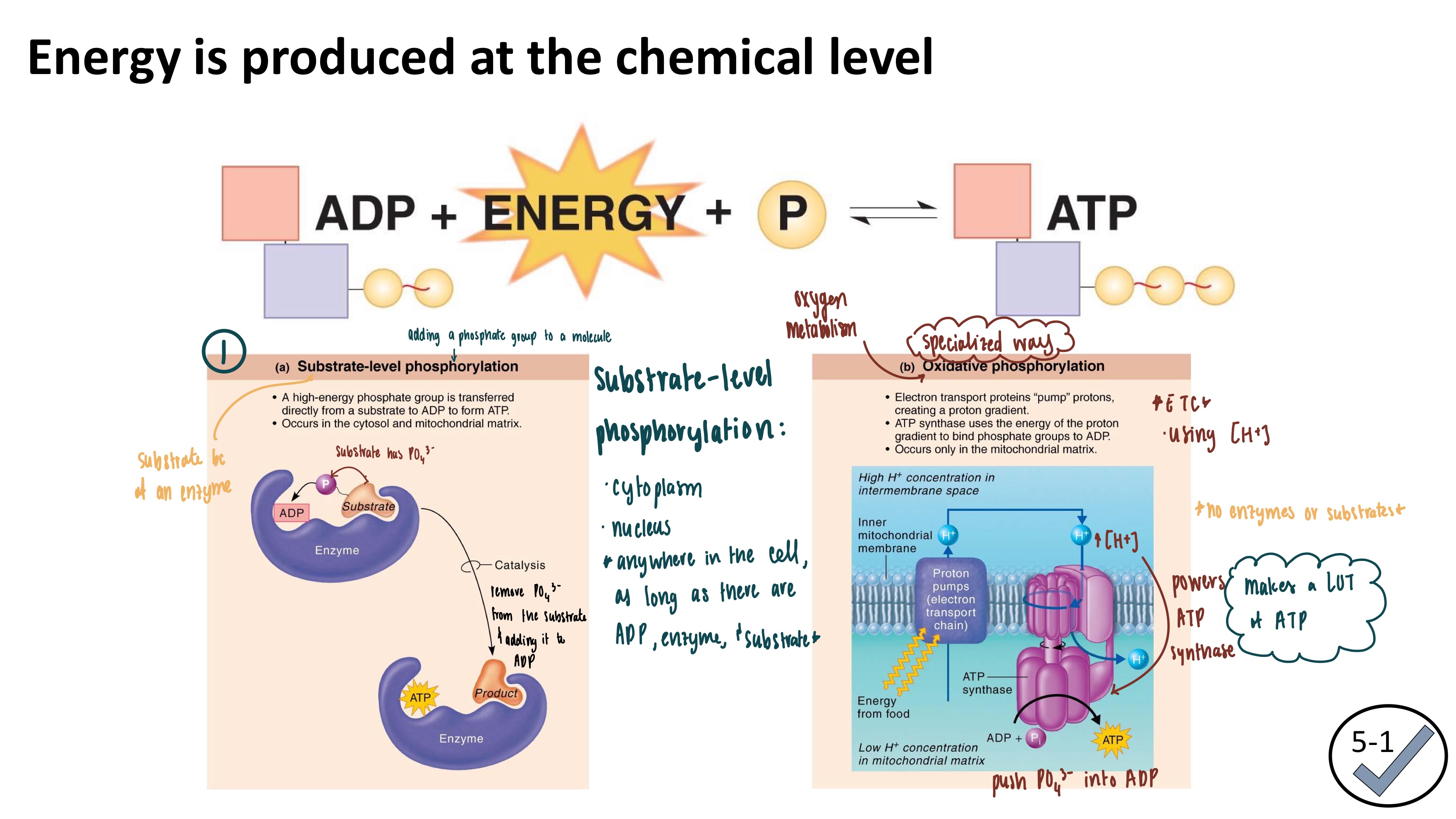
What are the 3 general steps to cellular respiration?
Which step produces the most ATP?
Of each of those steps, which ones use substrate-level phosphorylation and oxidative phosphorylation?
Cellular Respiration STEPS
Glycolysis
Substrate-level phosphorylation (ADP → ATP)
Citric Acid Cycle
substrate-level phosphorylation
produces NADH & FADH2
Electron Transport Chain
MAKES THE MOST ATP
oxidative phosphorylation (uses O2)

What is the activation energy of a reaction?
How do enzymes accelerate chemical reactions? HINT: the answer involves the activation energy of the chemical reaction energy.
Activation Energy
energy required for a chemical reaction to occur
Enzyme Function
LOWERS the activation energy of a reaction
Reaction occurs FASTER

What is a chemical reaction pathway (chemical pathways for short)?
In a chemical reaction pathway, what are the reactants, products, and intermediates?
Chemical Reaction Pathway: series of steps that transform reactants into products
Reactants: before reactions
Products: final result
Intermediates: produced & consumed after the beginning
How can chemical reactions be reversed?
Enzymes
In a couple of sentences, describe how chemical processes/reactions are controlled by enzymes.
Be prepared to predict how chemical pathways will change if enzyme activity changes.
Regulators
If the enzyme is present, the reaction will occur
No enzyme = no reaction
Time
reduce the reaction time
Increase reaction rate
Enzyme Activity Changes
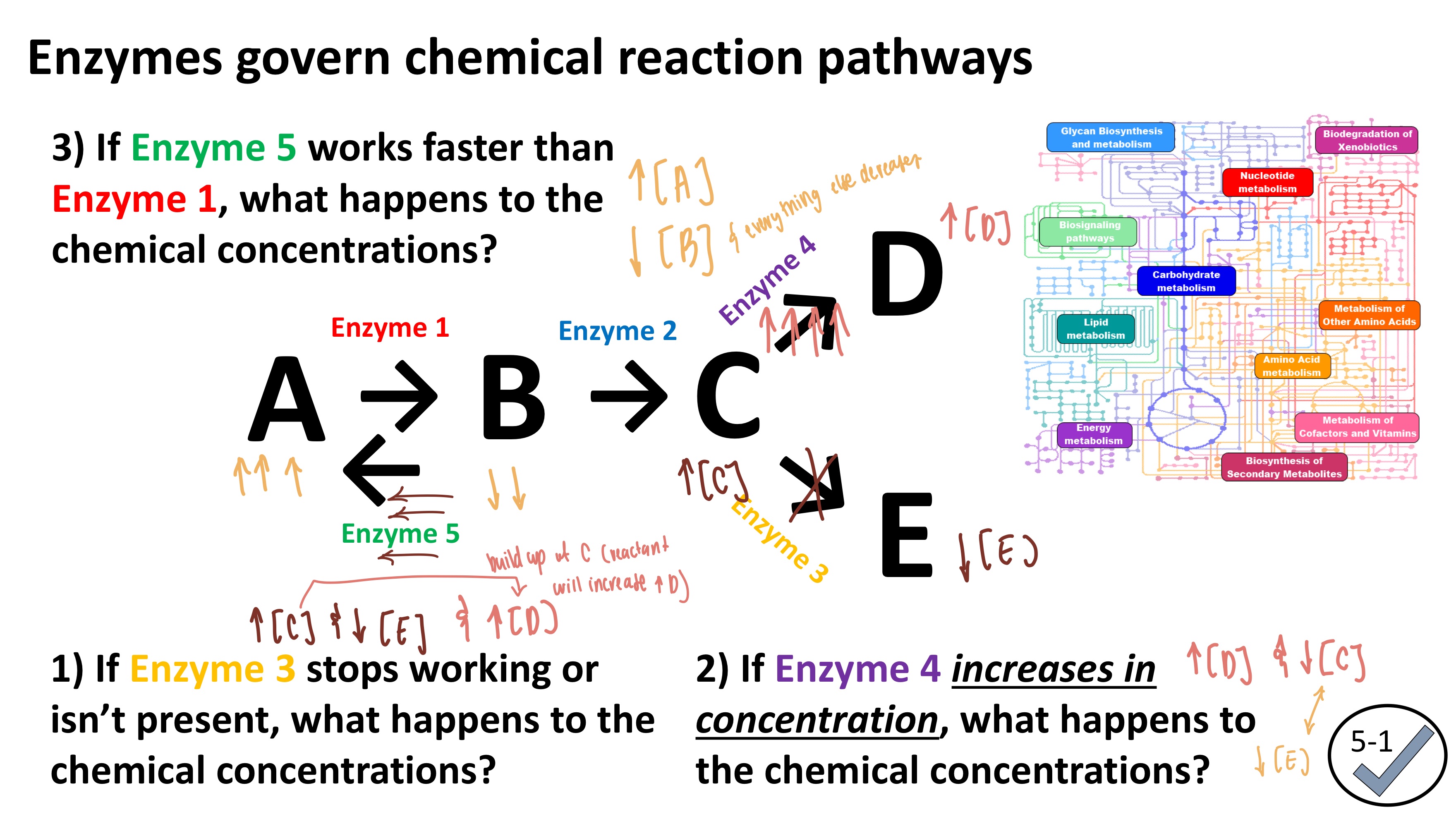
In 2-4 sentences, generally describe glycolysis.
Where does it occur in the cell?
Does it require oxygen to occur?
What are the reactants and products?
Glycolysis Function: first step of cellular respiration
Occurs in the cytoplasm
does NOT need O2
Reactants
Glucose
Products
Pyurvate
NADH (high energy electron carrier)
ATP
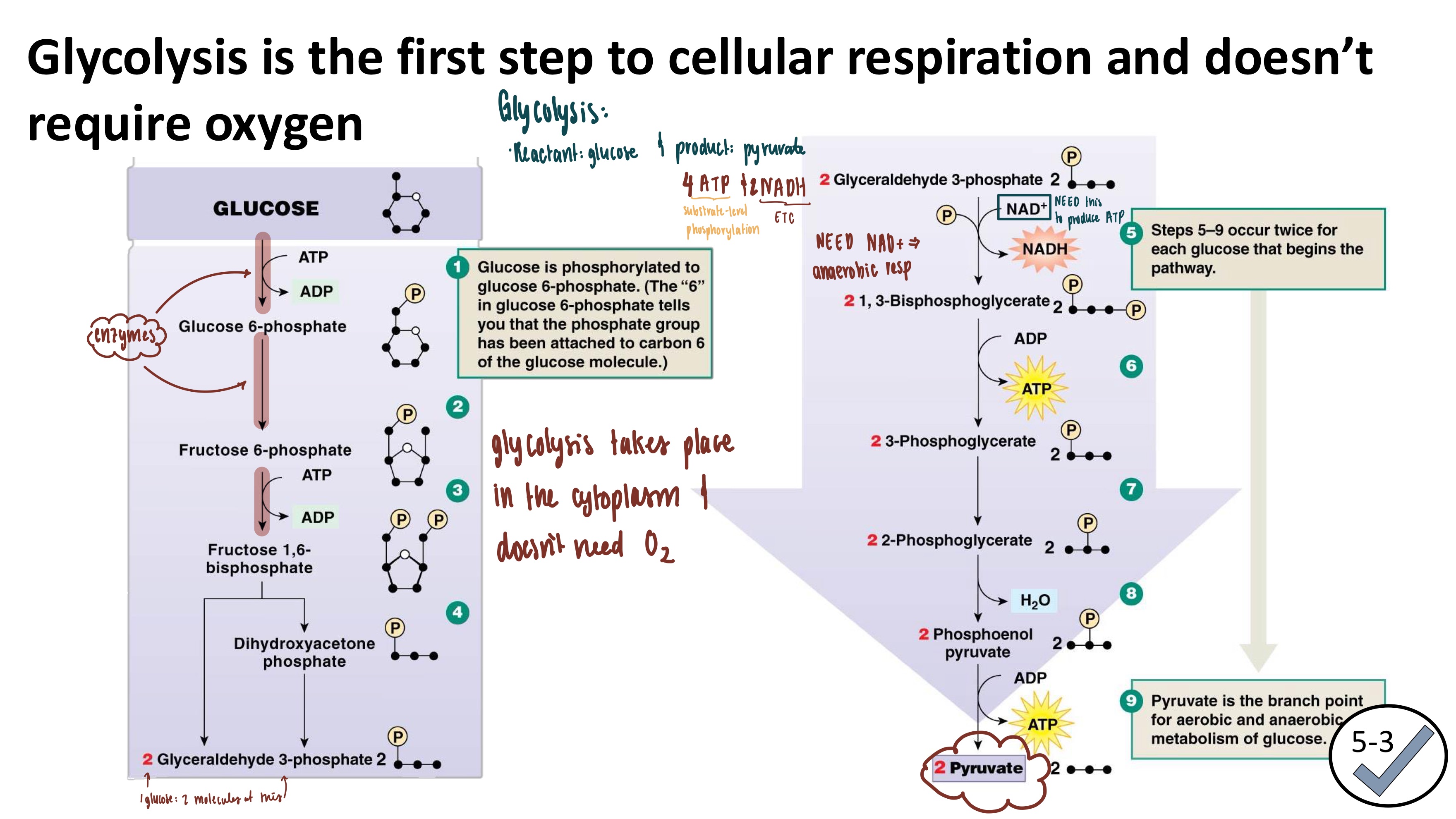
In the absence of oxygen, what happens to pyruvate and what is that process called?
How much more ATP does that process make?
How much ATP in total is created in anaerobic respiration (glycolysis + lactic acid fermentation) from one glucose molecule?
Lactic Acid Fermentation: allows glycolysis to continue WITHOUT O2 to CREATE MORE NAD+
Reactants
Pyruvate
NADH
Products
NAD+
Lactate (lactic acid)
NO ATP PRODUCED/USED (fermentation is only used to make more NAD+ !!!!)
2 ATP produced from glycolysis & lactic acid fermentation


In 2-4 sentences, generally describe the citric acid cycle.
Where does it occur in the cell?
How is oxygen involved in the citric acid cycle, and do the actual chemical reactions require oxygen to occur?
Citric Acid Cycle: a repeating pathway to produce as much NADH & FADH2 as possible
occurs in the mitochondrion
O2 needs to be present for pyruvate to ENTER the mitochondria & for the citric acid cycle to run
O2 is NOT chemically needed, just physically (needs to be present)
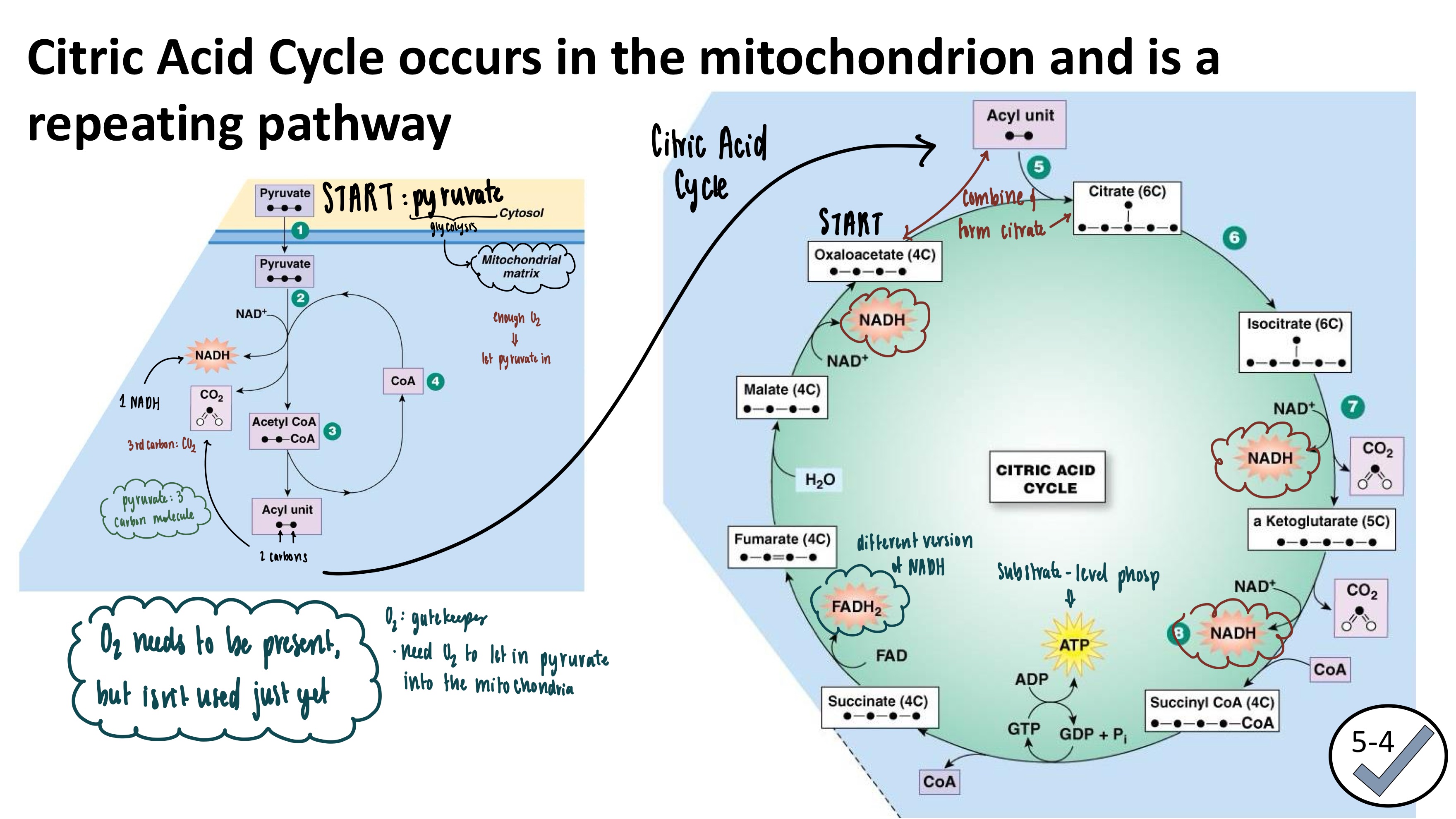
What is the initial reactant to the Citric acid cycle?
What are the by-products of the citric acid cycle?
Reactants
Pyruvate (product from glycolysis)
By-products
NADH
FADH2
ATP
CO2
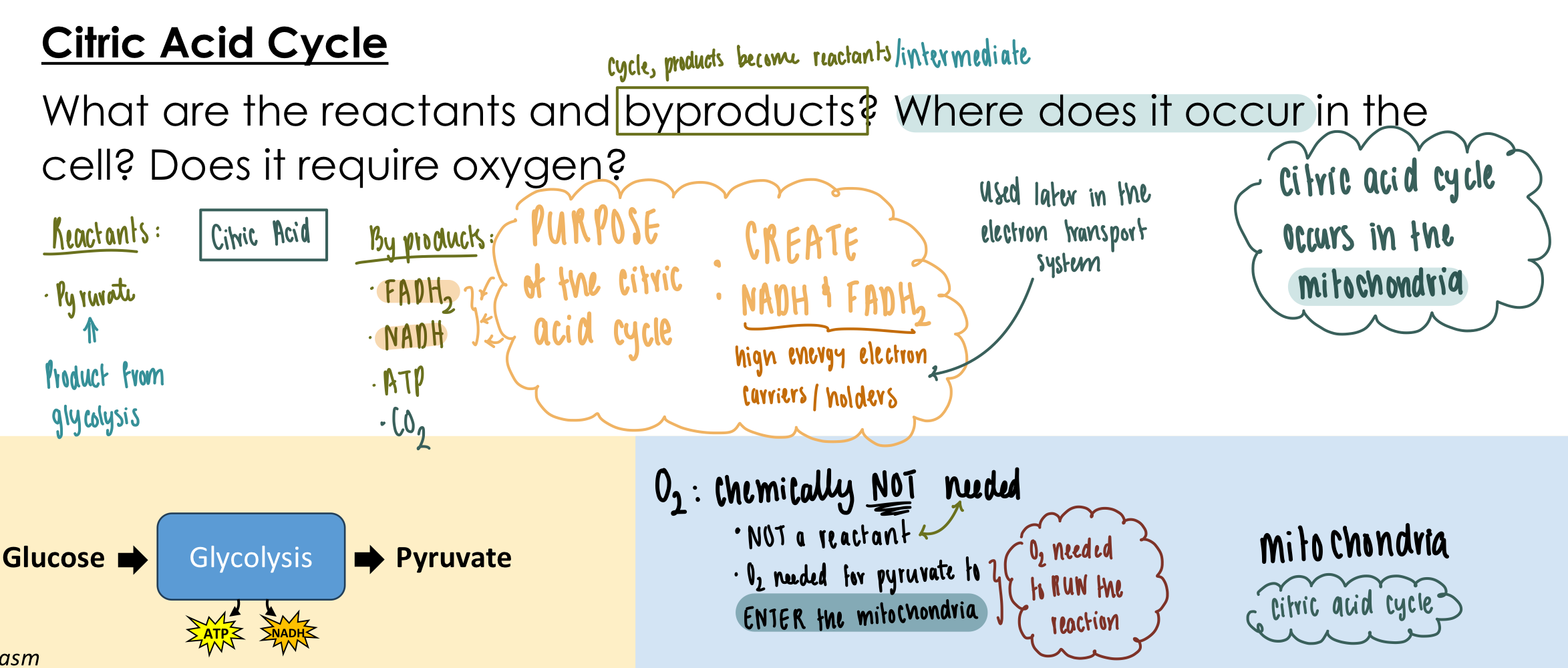
In 2-4 sentences, generally describe the electron transport chain.
Where can it be found in the cell?
Electron Transport Chain: uses oxidative (oxygen) phosphorylation to produce ATP from electrons
Occurs in the mitochondria
How is oxygen used in the ETC part of cellular respiration?
What are the reactants and products of the electron transport system?
O2 in the ETC: last electron acceptor
O2 + electrons + H+ → H2O
Reactants:
NADH: electron carrier
FADH2: electron carrier
O2: LAST electron acceptor
Products
ATP 🙂
H2O
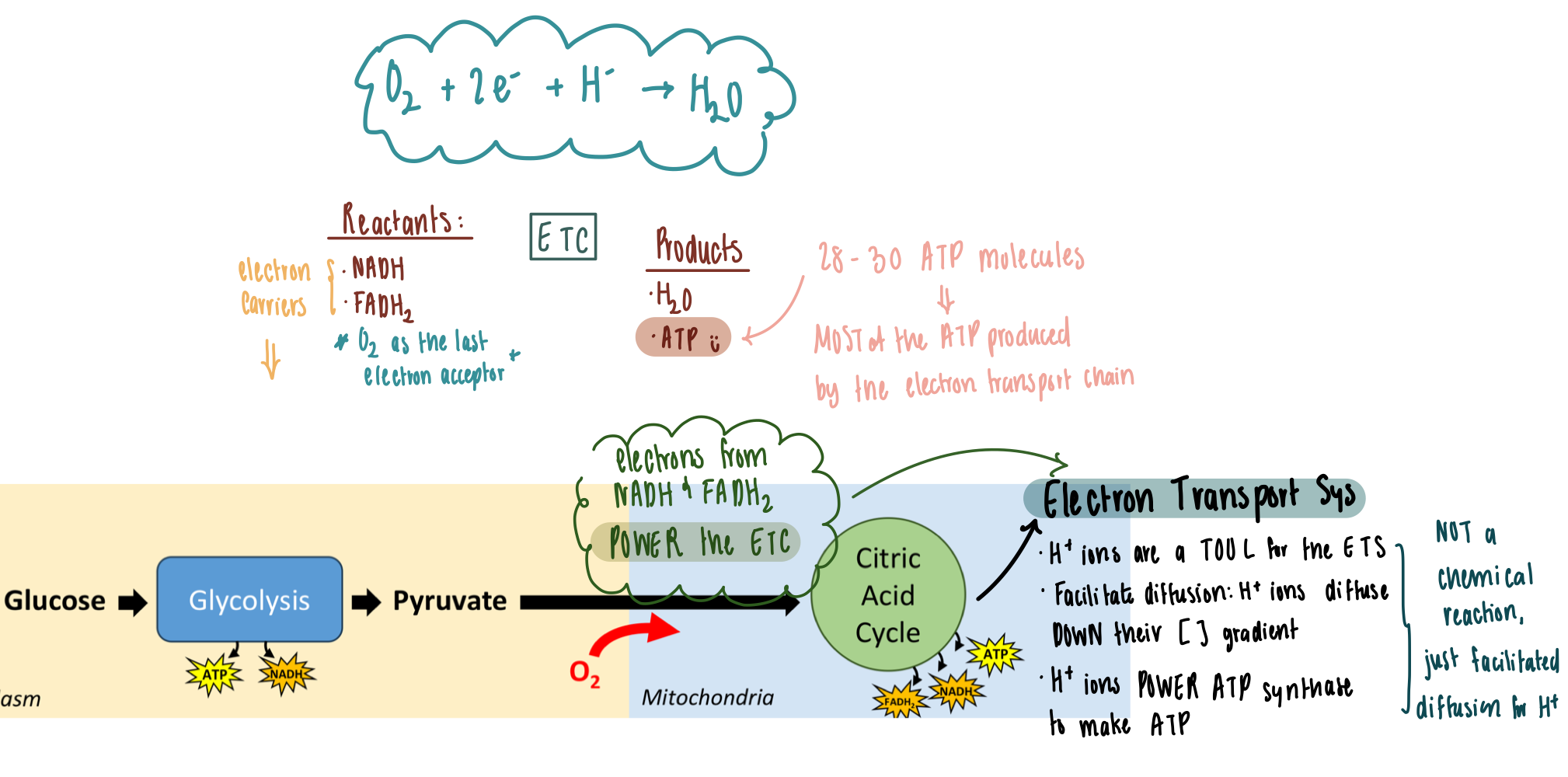
Why is the double membrane of the mitochondria required for the electron transport system?
Double membrane creates a concentration gradient for H+
H+ protein pumps on the inner membrane
accept electrons from NADH & FADH2
What is NADH and FADH2?
How are the electrons from NADH and FADH2 used to create ATP?
NADH & FADH2: electron carriers
Electrons and H+ are dumped into the electron transport chain proteins → H+ gradient is created → H+ facilitated diffusion powers ATP Synthase to create ATP
H+ gradient powers ATP Synthase

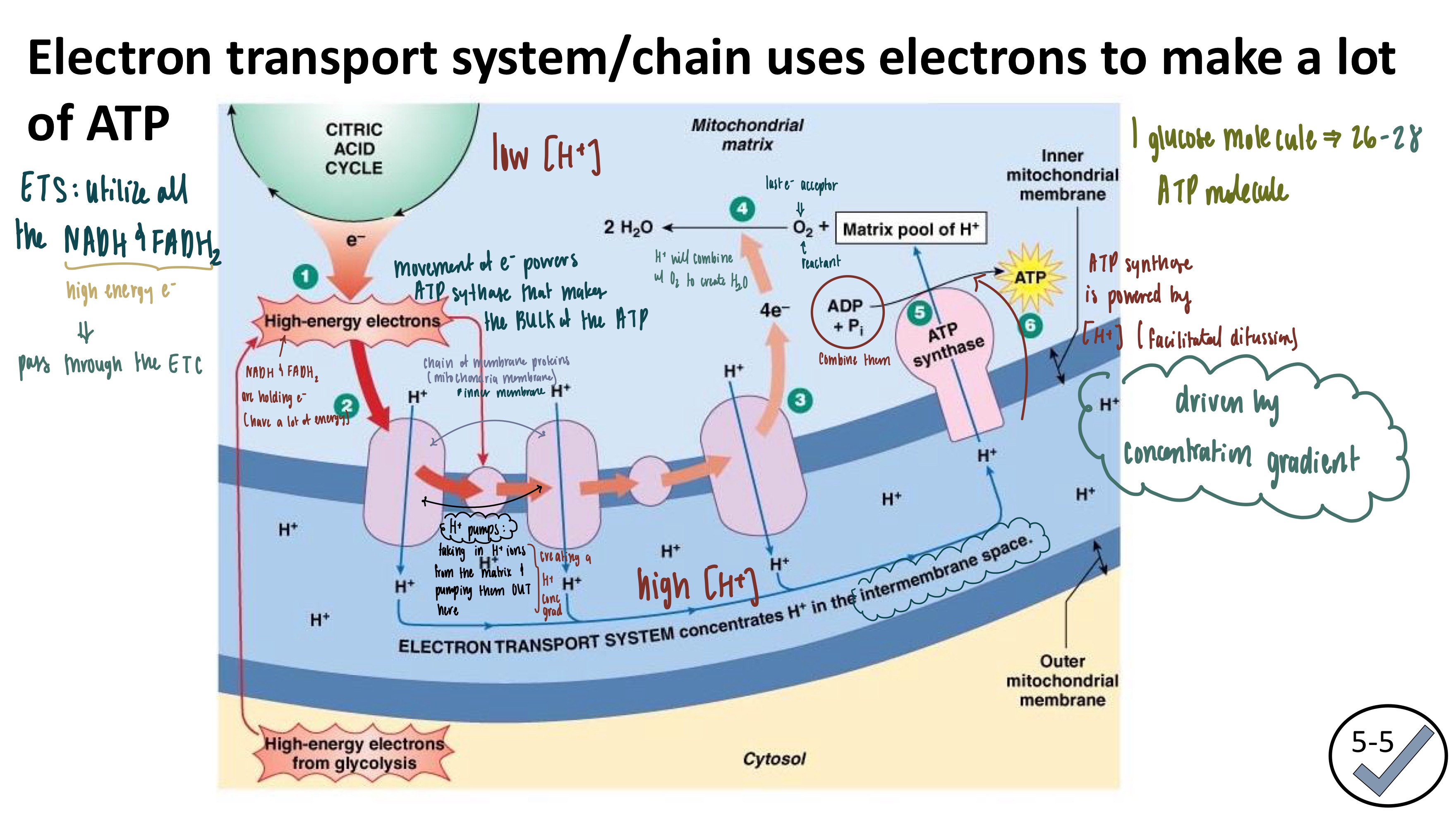
In a couple of sentences, describe what glycogen is.
Long-term storage for glucose, is a polysaccharide
What is glycogenesis?
Under what situations does glycogenesis occur?
What are the reactants and products of glycogenesis?
Which types of cells typically undergo glycogenesis?
Glycogenesis: storing glucose into glycogen for long-term storage
Occurs when cells are full of ATP & don’t need to do cellular respiration → fed state
Reactant: glucose → Product: glycogen
Liver & skeletal muscle cells perform glycogenesis

What is glycogenolysis?
Under what situations does glycogenolysis occur?
What are the reactants and products of the process?
Which types of cells typically use glycogenolysis?
Glycogenolysis: breaking down glycogen into glucose
Occurs when
Blood sugar levels are low
need glucose for cellular respiration
Reactant: glycogen → Product: glucose
Skeletal muscles & liver cells
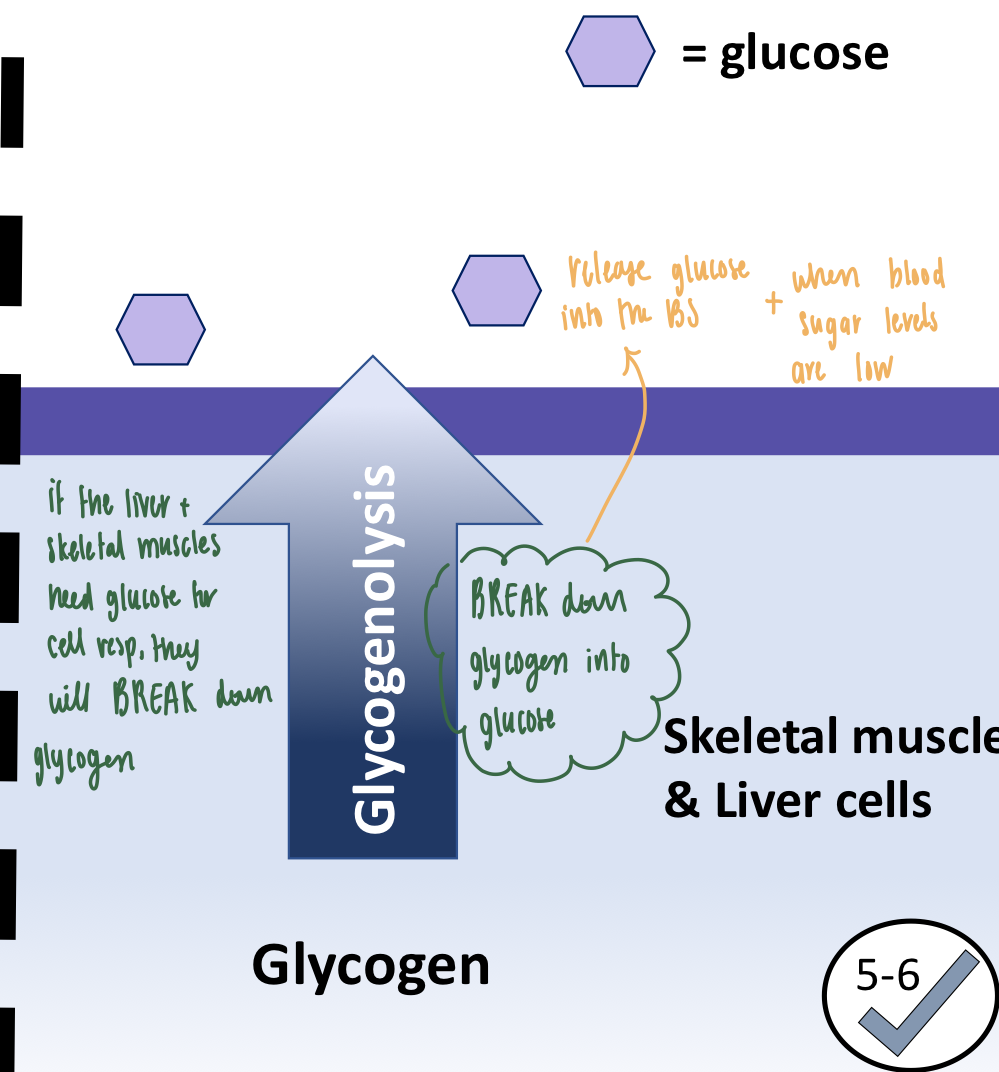
What is glyconeogenesis?
Under what situations does glyconeogenesis occur?
What are the reactants and products of the process?
Which types of cells typically use glyconeogenesis?
Glyconeogenesis: using non-glucose molecules to create glucose
Occurs when glucose is scarce
Reactants
Lactate
Amino Acids
Glycerol
Pyruvate
Product: glucose
Kidney but MOSTLY liver cells do glyconeogenesis
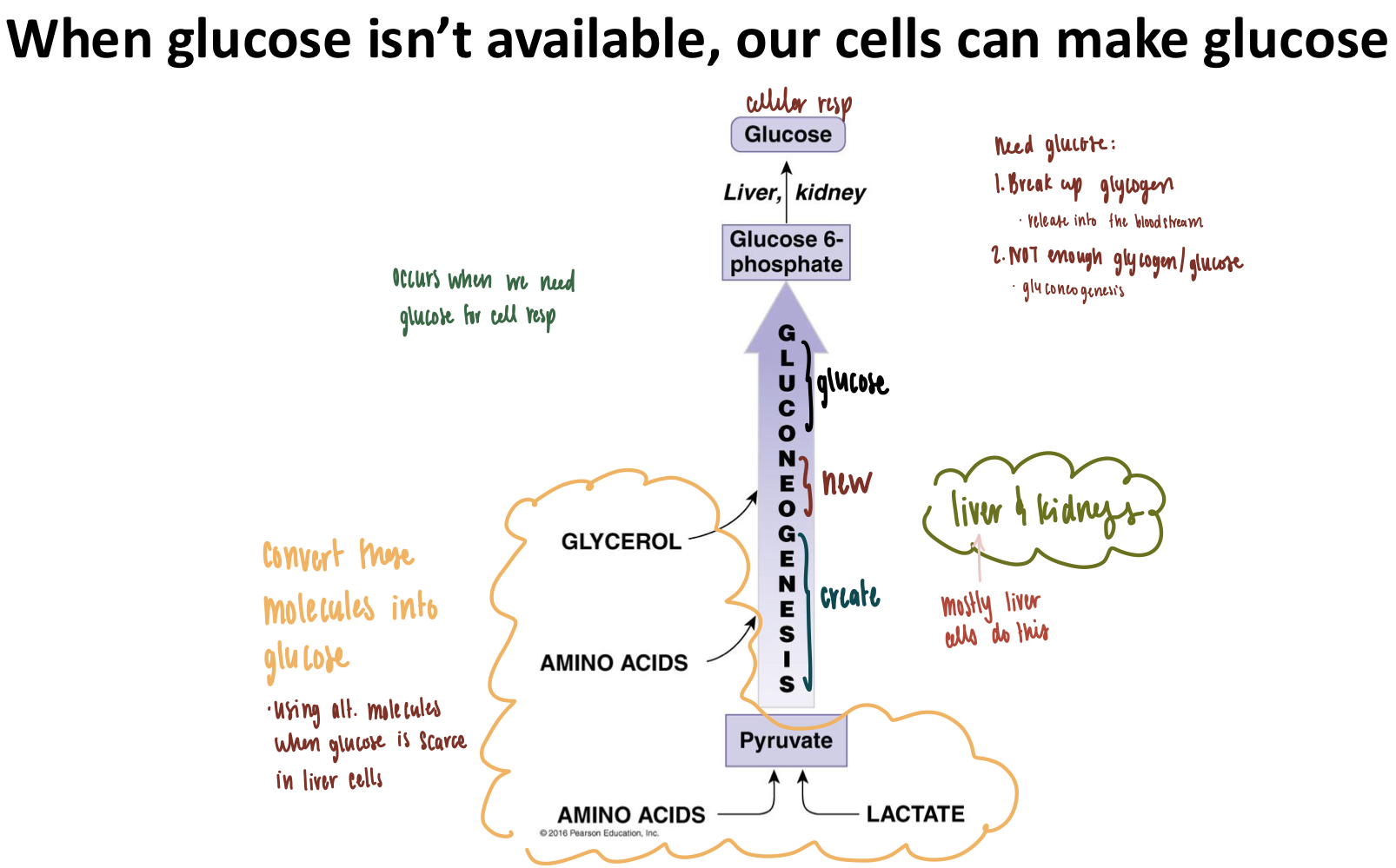
Which type of lipid is used for energy?
Triglycerides are broken up and used in cellular respiration for energy
How can glycerol and the fatty acid chains be used in cellular respiration?
Glycerol: glycolysis via lipolysis
Fatty Acid Chains: citric acid cycle via lipolysis FIRST, then beta oxidation

Beta oxidation process, reactants, and products
Beta oxidation: fatty acid chains are broken down into acetyl CoA for the citric acid cycle, NOT FOR GLYCOLYSIS
Occurs AFTER lipolysis (breaking down triglycerides into glycerol & fatty acid chains)
Reactant: Fatty Acid Chains
Product:
Acetyl CoA
NADH
FADH2

What is lipogenesis?
What are its reactants and product?
What chemical processes do the reactants come from in the cell?
Can carbohydrates ultimately be turned into fat using lipogenesis?
Lipogenesis: creating triglycerides from acetyl CoA, fatty acid chains, and glycerol
Reactants:
Fatty Acids
Glycerol
Acetyl CoA
Pyruvate
Come from (glycolysis) cellular respiration
Products
Triglycerides
YES, carbohydrates can be turned into fat
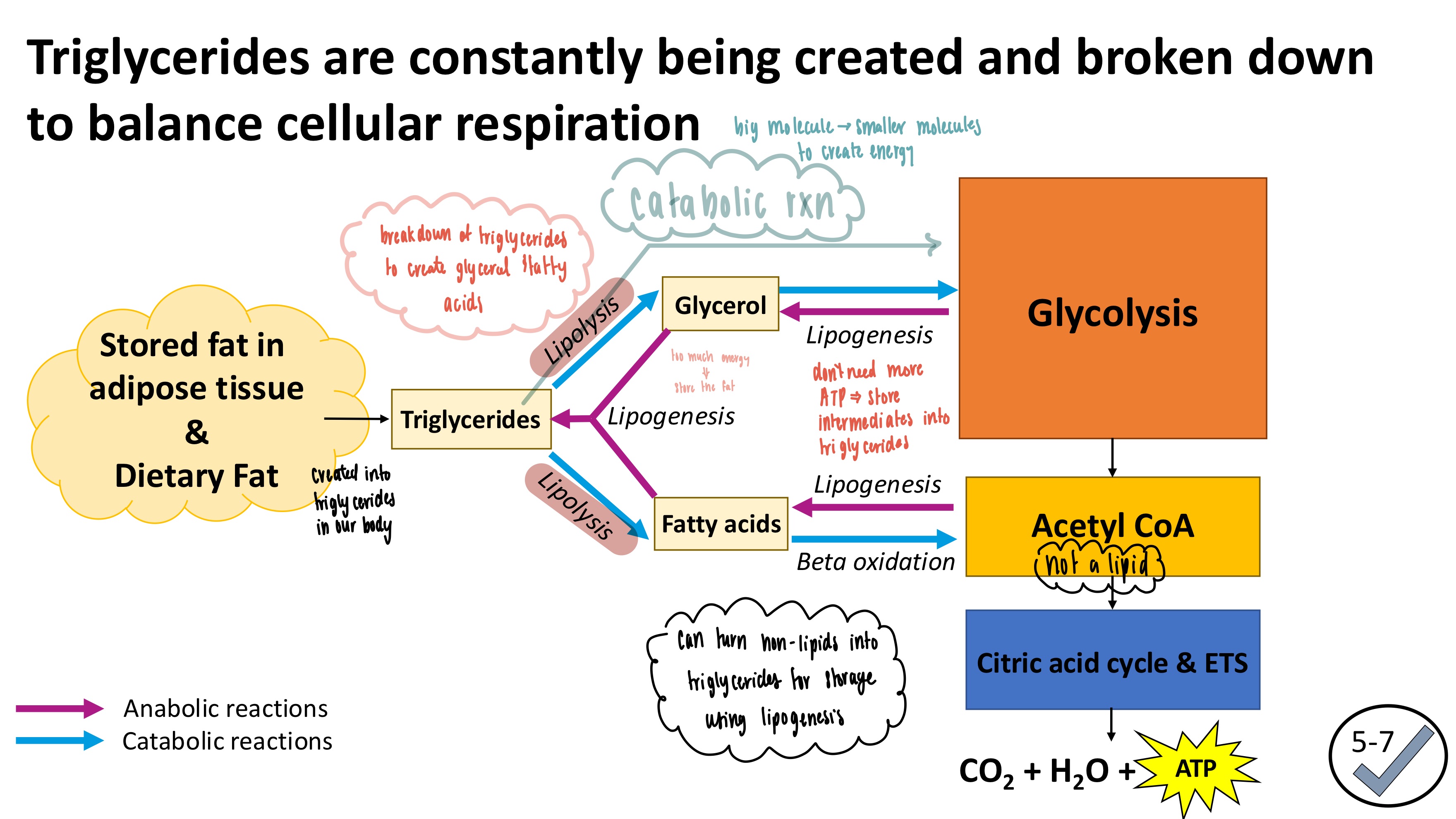
What is lipolysis?
Decomposition of triglycerides into glycerol and fatty acids
Catabolic reaction

Can amino acids be used in cellular respiration?
If so, which part of cellular respiration can use converted amino acids?
What is deamination?
Deamination: transformation of an amino acid to an organic acid so it can be USED in cellular respiration
Used in
Glycolysis (some amino acids)
Citric Acid Cycle
DEAMINATION IS IRREVERSIBLE

Be able to describe how various non-glucose molecules can become glucose using the pathways of cellular respiration. Note: This is basically describing gluconeogenesis by specifically describing the chemical pathways taken in cellular respiration.
Lipids (triglycerides)
Lipolysis:
Reactant: triglyceride
Product: glycerol & fatty acid chains
Glycerol for glycolysis
Beta oxidation
Fatty Acid →acetyl CoA for the citric Acid cycle
Amino Acids
Deamination
Reactant: some amino acids
Product: pyruvate OR citric acid cycle intermediates
Glycogen
glycogenolysis
Reactant: glycogen
Product: glucose
Used for glycolysis
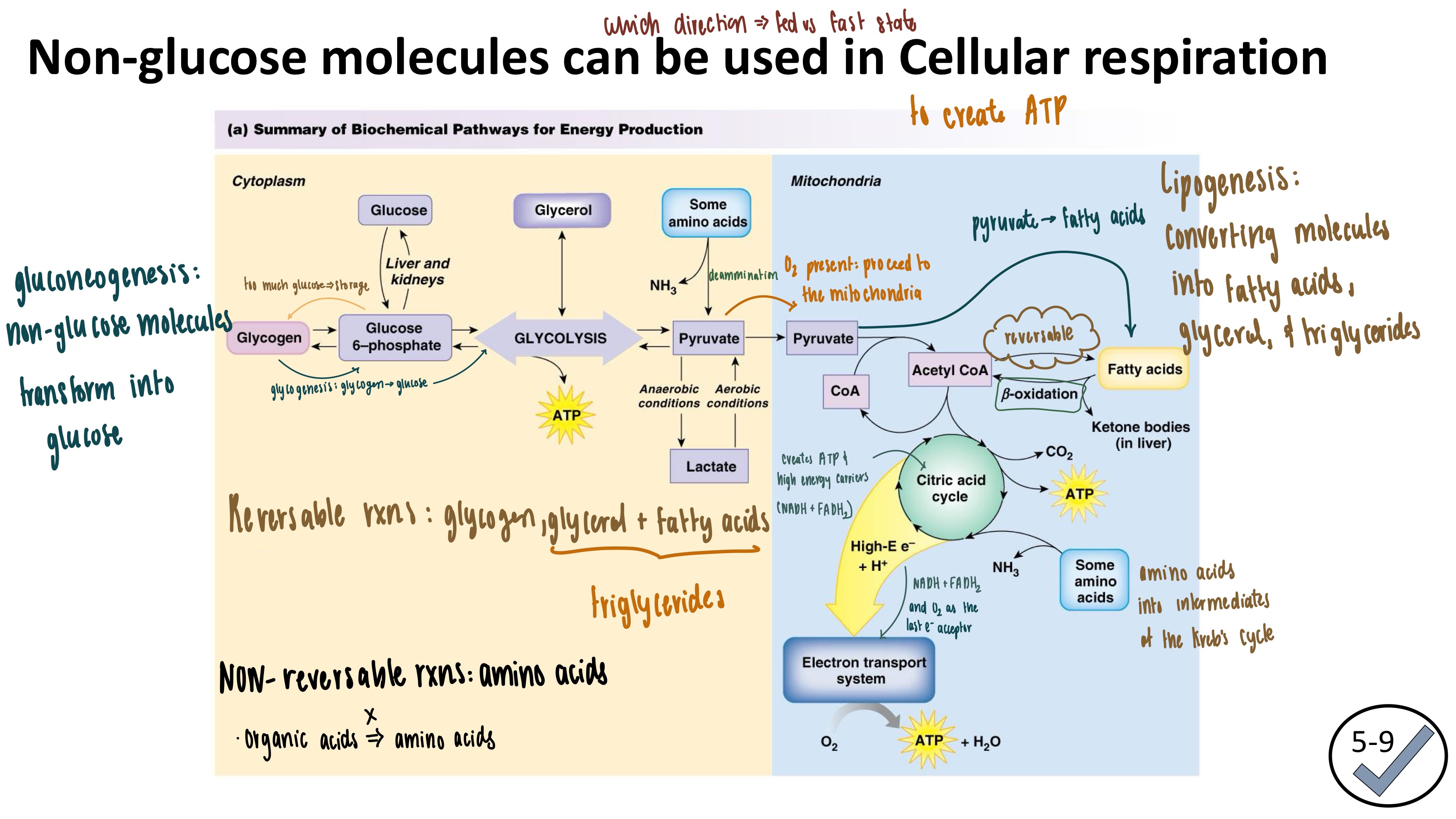
When does the fed and fasted state occur in the human body?
Fed State: 4 hours since the start of eating
Fasted Sate: after 4 hours
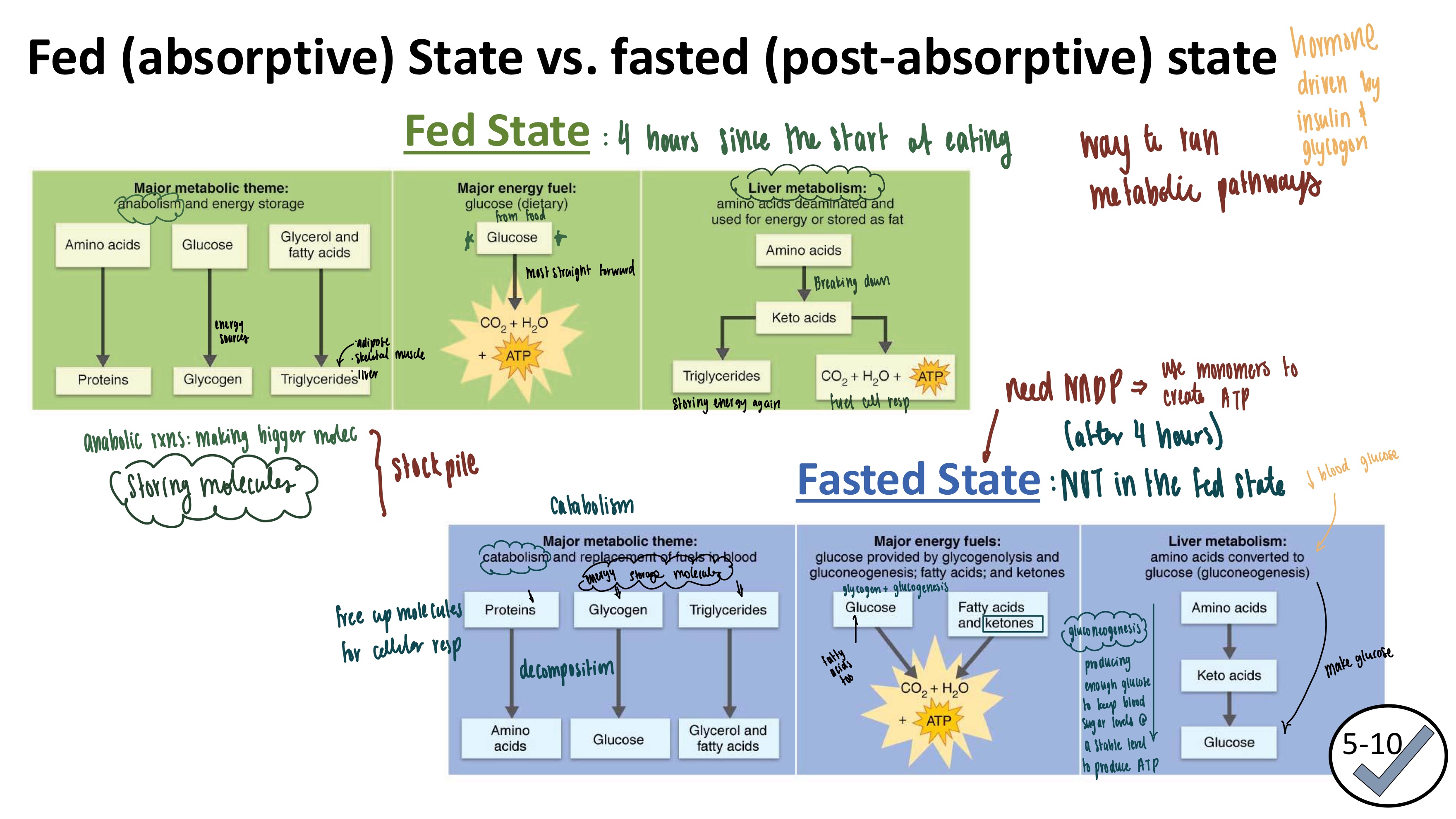
Describe the movement and processing of carbohydrates, triglycerides, and amino acids during the fed state.
Make sure to explain what happens in the liver, skeletal muscle organs, adipose tissue, and all other cells.
GI Tract (absorbing nutrients from the small intestine)
Glucose
glycogenesis (glucose → glycogen)
Skeletal muscle cells
Liver cells
Lipogenesis (glucose → triglycerides)
Adipose tissue
Liver cells
Amino Acids
Storage
Muscles
Liver
Deamination
amino acids into triglycerides
Glycerol & Fatty Acids
Lipogensis: (glycerol & fatty acids → triglycerides)
adipose tissue
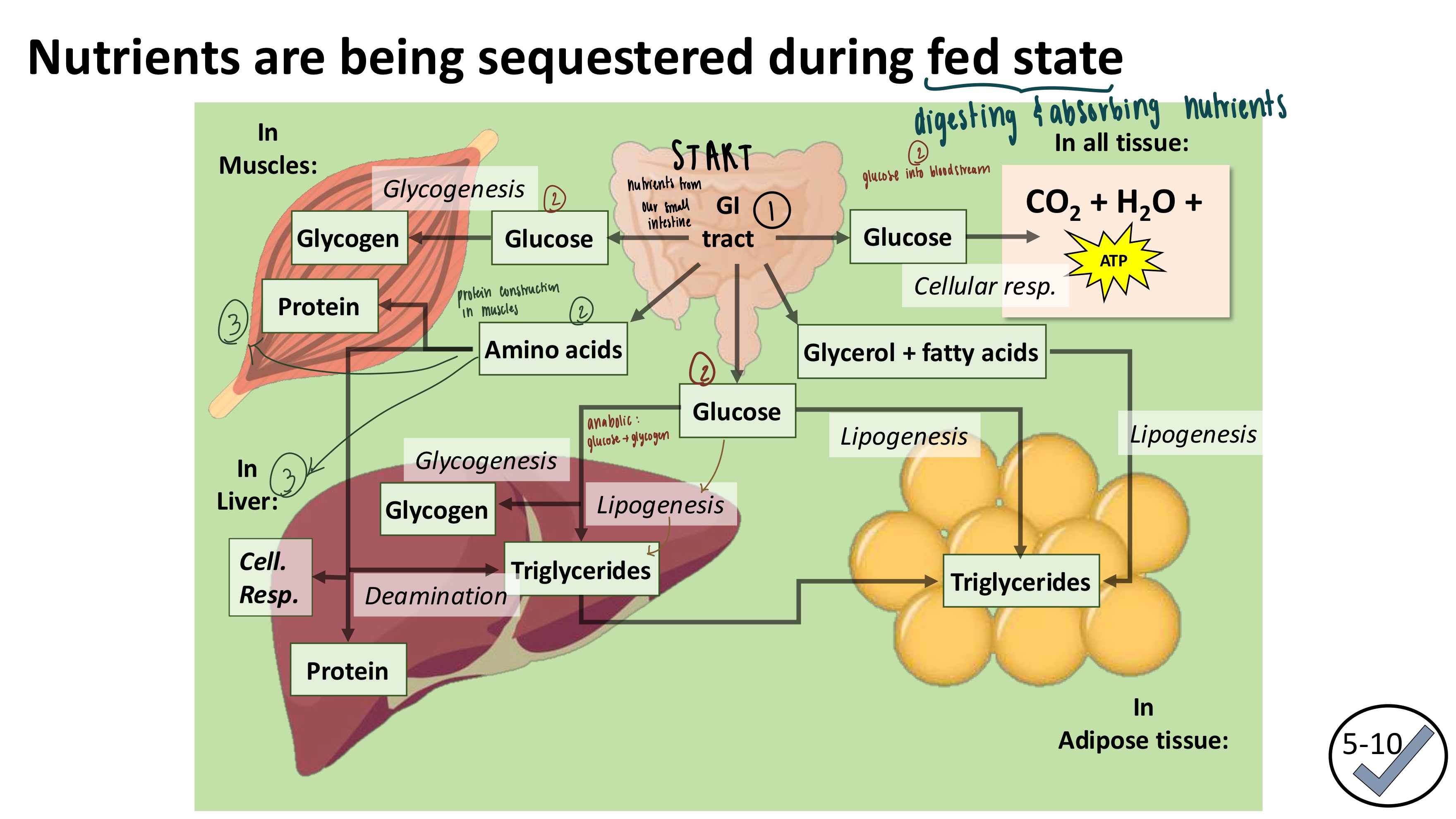
How do nutrients like glucose and amino acids travel from the GI tract to other parts of the body? Be specific.
Why can’t this work for fatty acids?
Glucose & amino acids: bloodstream
Secondary active transportation INTO intestinal cells
facilitated diffusion OUT of the cell
Passive diffusion into the blood capillaries
Hepatic portal vein → Liver
Rest of the systemic circuit
Fatty acids are nonpolar & hydrophobic → don’t mix well with water
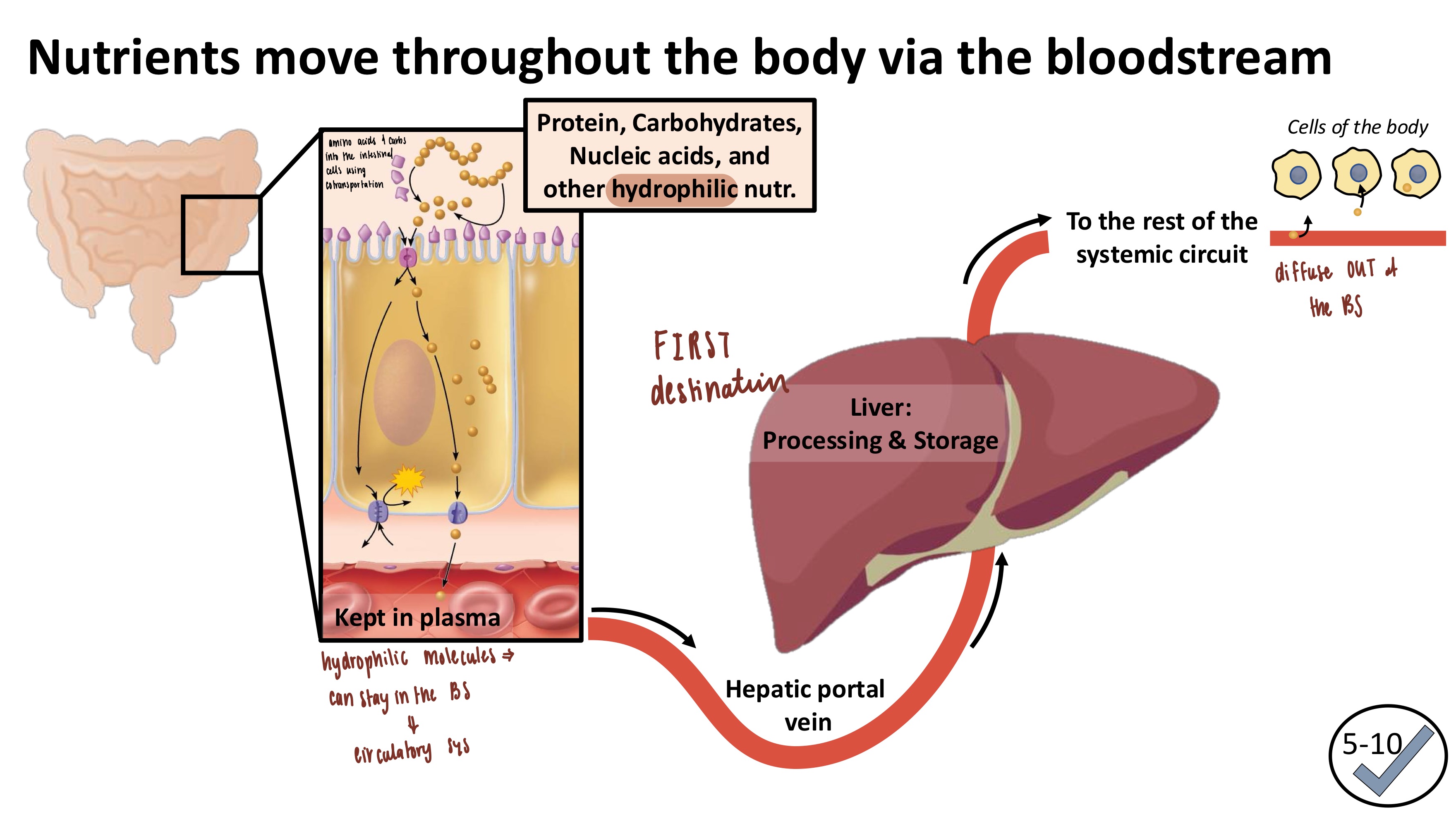
How are cholesterol and fatty acids transported throughout the body?
What molecular structure is used?
Lympathic system: transport chylomicrons (lipid packages) to the body
Lipoproteins: transport larger lipids throughout the body
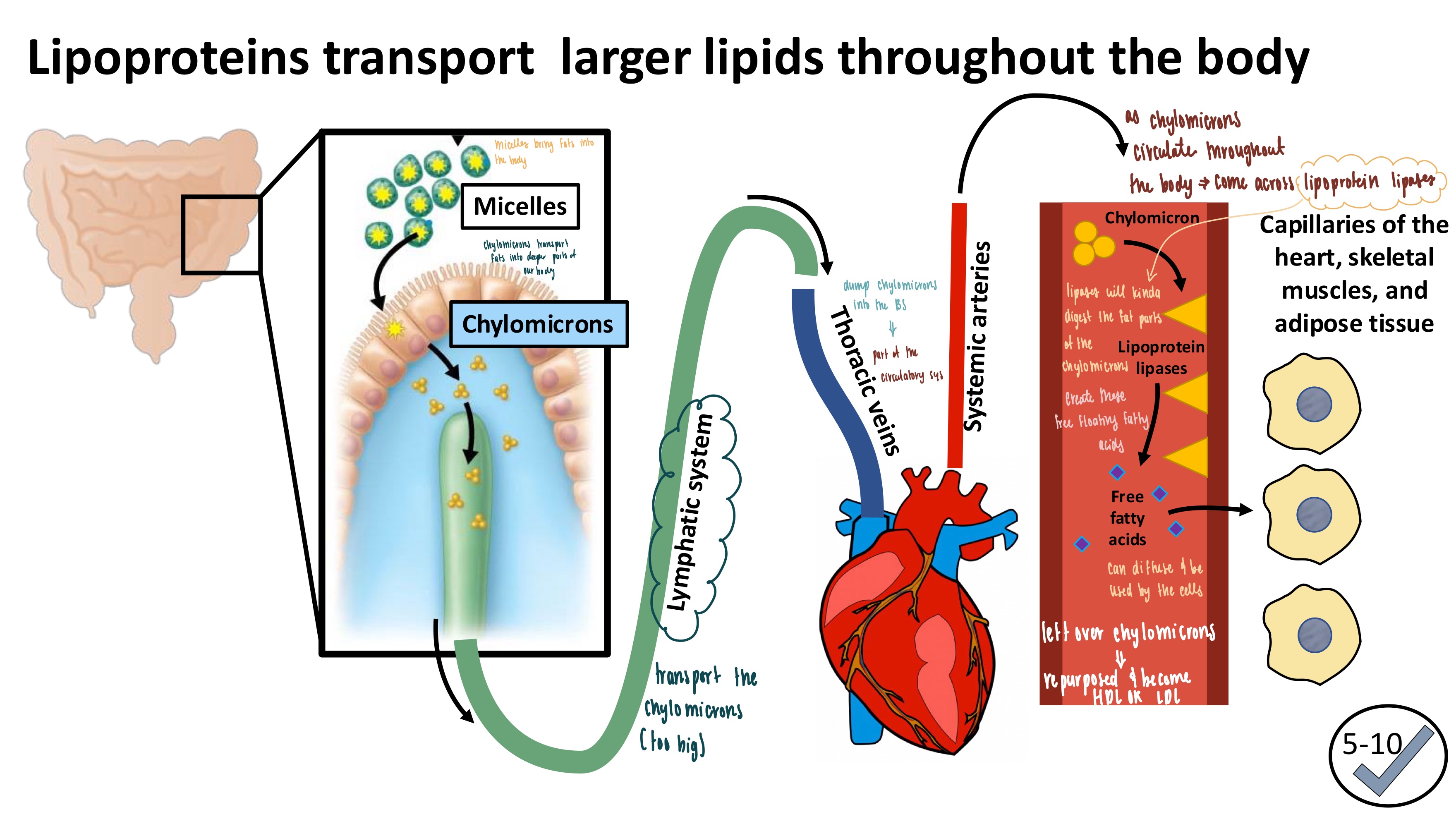
Describe the movement and processing of carbohydrates, triglycerides, and amino acids during the fasted state.
Make sure to explain what happens in the liver, skeletal muscle organs, adipose tissue, brain, and other cells.
Proteins: deamination
protein → amino acids
liver cells
Carbohydrates: glycogenolysis
glycogen → glucose
Muscle & Liver cells
Lipids:
lipolysis
Triglycerides → glycerol & fatty acids
glycerol → glucose
adipose tissue & liver
beta oxidation
fatty acids → acetyl CoA
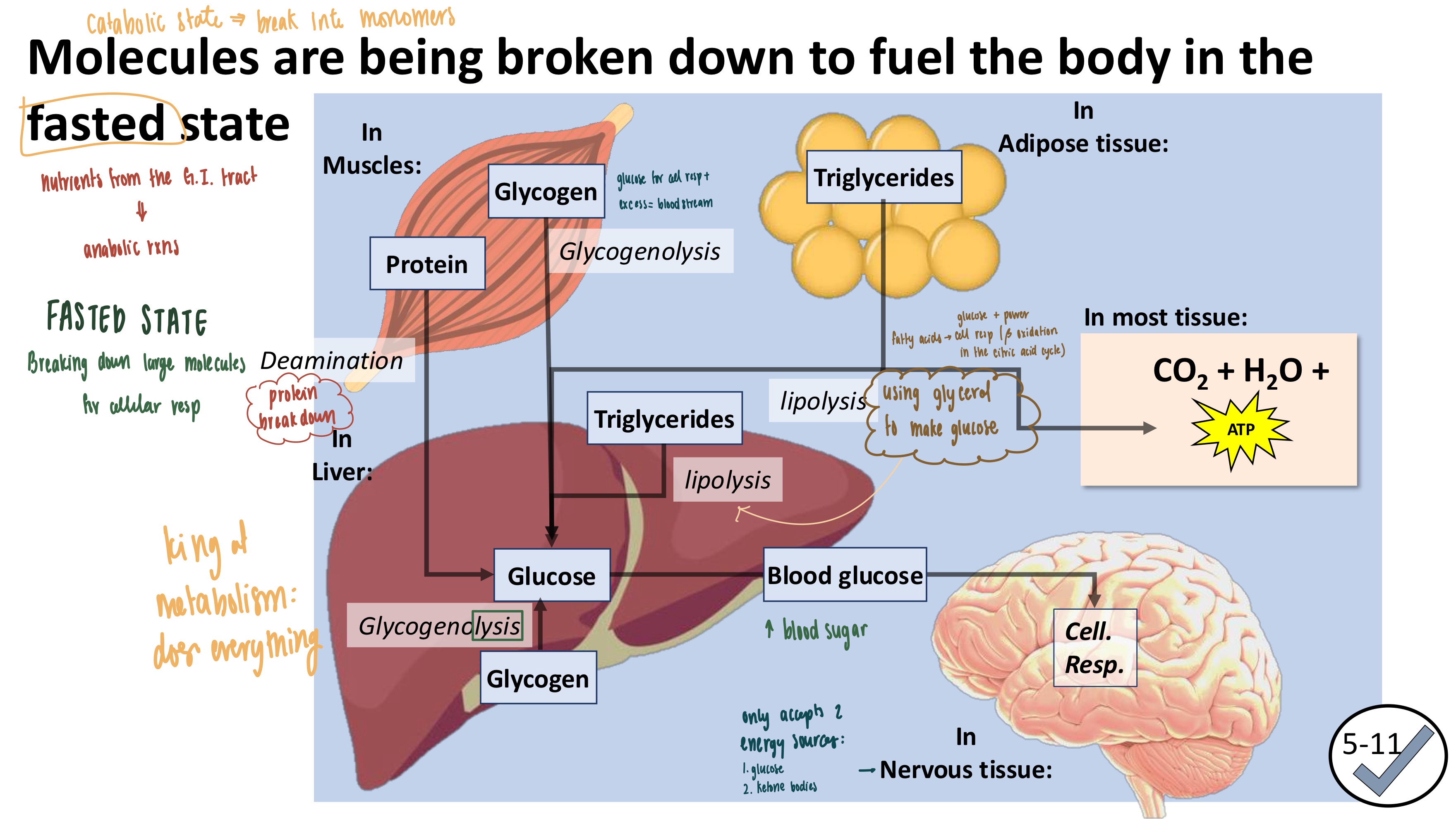
What hormone triggers the fed state, and which hormone triggers the fasted state?
Where do both hormones come from (Be specific)?
Fed State Hormone: insulin
too much blood sugar from food → need to decrease blood sugar → store it
Glycogenesis: glycogen synthesis
Lipogensis: fat synthesis
Protein synthesis
Fasted State Hormone: glucagon
LOW blood sugar → NEED to increase it → breakdown stuff
glycogenolysis: breakdown glycogen
gluconeogensis
amino acids, triglycerides, pyruvate, lactate, etc into glucose
Ketogenesis
